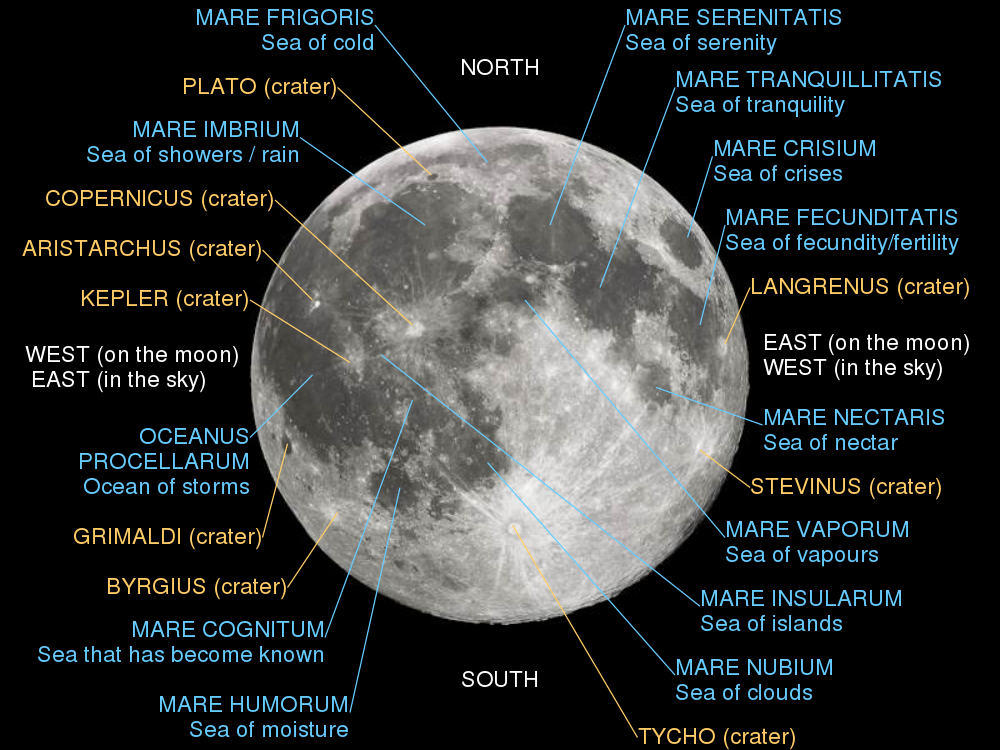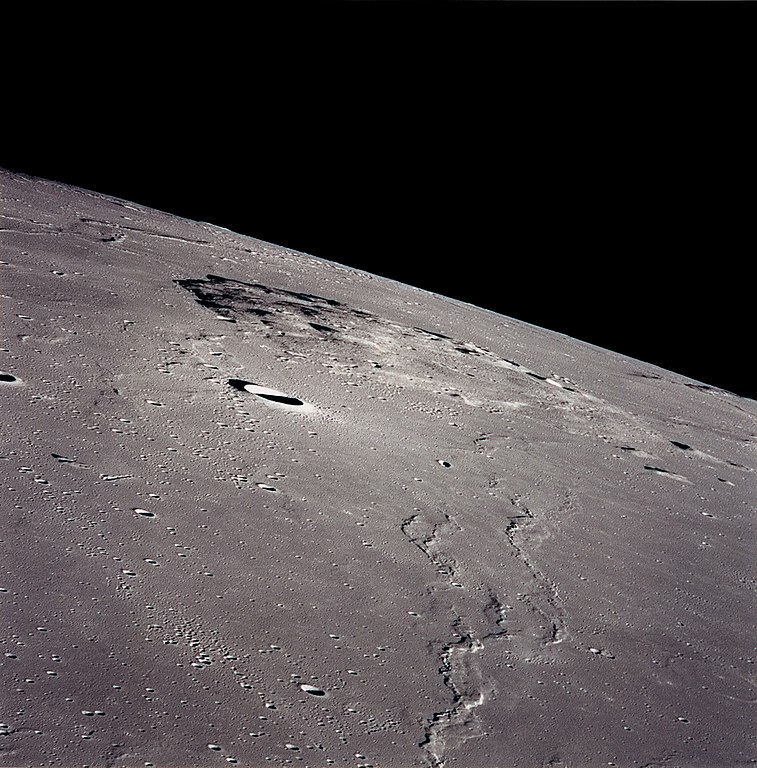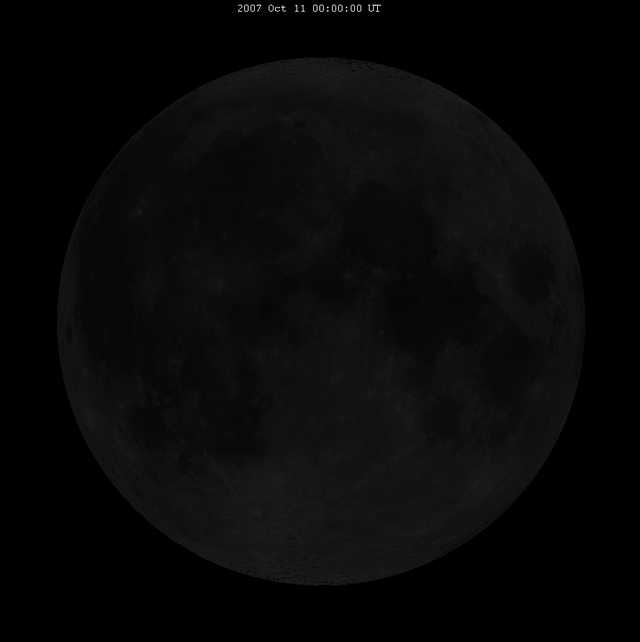


Caption: Earthrise: "The most influential environmental photograph ever taken."---Galen Rowell (1940--2002).
The photo was taken by astronaut William Anders (1933--) on Apollo 8, 1968 Dec24.
Because of tidal locking (AKA synchronous rotation), the Moon's orbital period and rotational period are the same and the Moon always turns one side toward the Earth, the near side of the Moon.
So Selenites would always see the Earth at a fixed point in the sky relative to the surface: i.e., at fixed horizontal coordinates.
An earthrise could only be seen from an orbiting spacecraft.
Credit/Permission: NASA, William Anders (1933--), 1968 (uploaded to Wikipedia by Marcus (AKA User:Saperaud), 2005) / Public domain.
Image linked to Wikipedia.
Supplementary Lab Preparation: The items are often alternatives to the required preparation.
The quiz might be omitted if it's not feasible or convenient. The students may or may not be informed ahead of time of quiz omission depending on the circumstances.
The quizzes in total are 40 % of the course grade. However, only the top five quiz marks are counted.

Caption: St. Nestor the Chronicler (c. 1056--c. 1114), St. Vladimir's Cathedral, Kiev, Ukraine.
At his studies.
Credit/Permission: Viktor Vasnetsov (1848--1926), 1919 (uploaded to Wikipedia by User:Butko, 2006) / Public domain.
Image linked to Wikipedia.
In preparing for a quiz, go over the Required Lab Preparation.
The Supplementary Lab Preparation (see above) could help, but is only suggested if you feel you need more than the required Required Lab Preparation.
There is no end to the studying you can do, but it is only a short quiz.
One to two hours prep should suffice.
There will be 10 or so questions and the time will be 10 or so minutes.
The questions will range from quite easy to challenging.
The solutions might be posted at Moon: Quiz Solutions. after the quiz is given. Whether they are or not depends on the circumstances of each individual semester.

Caption: Plato (428/427--348/347 BCE) and Socrates (circa 469--399 BCE) in a Medieval image.
Here the disciple seems to be instructing the master/mentor using the Socratic method.
The basic pose is much like in intro labs.
Credit/Permission: Medieval artist, Middle Ages (probably 1000--1400) (uploaded to Wikipedia by User:Tomisti, 2007) / Public domain.
Image linked to Wikipedia.
In case the weather is not good for observing, you need to have an alternate indoor lab ready.
Usually the alternative should come from the current semester Lab Schedule. If that is NOT possible, yours truly suggests Lab 16: Hubble's law since that is pretty short and easy and takes little prep.
On the other hand, you could do all the inside part on the bad night and do the rest next week if the Moon is still in a good position.
Someone will make an executive decision.
The sky map below has to be updated for the observation night.
The C8's can be sky aligned for this lab, so that the Moon stays fixed in the field of view while the students sketch it.
But on the other hand, the Moon is easy to find and the students can keep it in view by continually adjusting their scopes.
So sky alignment is optional for The Moon lab.
See Telescope Operation for procedures and tips.
Since the Moon is likely to be near full moon (since that is when it is best to do the The Moon lab), one should put the Moon filters to save the eyes from glare.
They screw on and off the bottom of the 40-mm eyepieces.
Don't screw them on too tight.
If you have to shoot through clouds, you should leave the Moon filters off. The clouds will probably provide more than enough filtering.
But I suggest leaving them on. The orientation is easy to get: Tycho is at the mid-south, Kepler is at the mid-east (on the sky).
Direct naked-eye observations of the Moon while sketching should give the students the right orientation anyway.
It is possible to cover all parts of the lab in one week, but be sure to decide among the instructors how to proceed in order to avoid chaos on the roof.
As many C8's as needed should be set up and the instructors should decide ahead of time how to share them.
When the class is present take a Moon image showing the class the steps. Then put the image on the dome computer, transfer it somehow to the computer in the telescope control room (Bigelow Physics Building (BPB) 230), and then transfer the image to the lab computers for the students to process as part of the lab.
But you only need to set up the CCD camera and take an new image if you really, really want to.
It's a lot of extra bother for the instructors for what it is worth to the students.
You can just provide the students with an old image to process such as moon_2013_02_21_waxing_gibbous.FIT or moon_2013_02_26_full.FIT.
Actually, students can often take Moon images with their cell phones. That's a lot more fun for them. We can't process the images, but often they look great anyway.
Post the largest poster Moon map on the bulletin board.
Go over some of the following items: lunar phases, tidal locking, (AKA synchronous rotation), lunar geology, and lunar features.
Use images to illustrate the items.

Caption: "Red foxes (Vulpes vulpes) at the British Wildlife Centre, Horne, Surrey, England." (Slightly edited.)
Credit/Permission: © Keven Law, Photo 2008 Aug17 / Creative Commons CC BY-SA 2.0.
Image linked to Wikipedia.
In this lab, we go from "low tech", the naked-eye sketch, to "high tech", the CCD image---which we usually don't take ourselves.
The observing part of the lab is intended to proceed this way:
Walled plains and especially rilles might challenging to identify.
You should take turns sketching. One person will see what another will not.
Prominent features or especially obvious isolated features in the maria are good things to sketch since they are easiest to find later in the lab on the Moon map.
For the new image case, every group will get a copy of the CCD image.
For the past case use moon_2013_02_21_waxing_gibbous.FIT or moon_2013_02_26_full.FIT.
Use the one whose phase is closest to the phase of the lab night.
Download the image from here or find it in the Lab 4 folder or someplace else on the computers. To fill in the image data, use today's date and the approximate time of your observations, and leave the other data items blank.
Process and analyze the new or old image just as directed in the lab manual.
Now let's get the big picture from the Moon map of near side of the Moon shown below.
In the giant impact hypothesis, the Moon formed about 4.5 Gyr ago from debris ejected from the Earth by the giant impactor.
This was very early on in solar system evolution since the Solar System formed about 4.6 Gyr ago. (Wikipedia: Formation and evolution of the Solar System: Timeline of Solar System evolution).
The giant impact hypothesis is a pretty robust theory, but there are still doubts about aspects of it.

Caption: "Animation of Theia possibly forming in Earth's L5 point and then drifting into impact. The animation progresses in one-year steps (before impact) making Earth appear not to move. The view is of the south pole."
The L4 and L5 points are 2 of the 5 Lagrangian points where a small body can be in a equilibrium position relative two much more massive mutually orbiting bodies.
L4 and L5 points are stable in that a small body put there will tend to stay there (Wikipedia: Lagrangian point: Stability). If one of the massive bodies is much smaller than the other, the L4 and L5 points lie nearly on the orbit of the smaller one about the larger one at leading and trailing positions of about 60 degrees along the orbit
The Trojans stay in these orbits quasi-perpetually.
Somehow gravitiational perturbations destablize Theia and send it off to become the giant impactor of the giant impact hypothesis of the origin of the Moon.
The giant impact hypothesis posits the Moon formed after being hit by a protoplanet which has come to be called Theia.
Image linked to Wikipedia.
After formation of the Solar System, there was a heavy bombardment that carried on from maybe carried on until maybe about 3.8 Gyr ago. There may have been an especially active late heavy bombardment (4.1--3.8 Gyr).

Caption: Artist's conception of the Moon during an active moment in the late heavy bombardment and the Moon today.
Both images have north at the bottom and south at the top.
During the late heavy bombardment, impactors were much more frequent than today. Nevertheless, most of the time nothing was happening. Having multiple impactors in a short time period as the image suggests was probably a rare occurrence.
So the image has been chosen for high drama.
Credit/Permission: © Tim Wetherell, 2010 / Creative Commons CC BY-SA 3.0.
Image linked to Wikipedia.
There was no sharp ending to the heavy bombardment. The cratering continues to the present present at a probably continually declining rate.
In the heavy bombardment, planetesimals, asteroids, and meteoroids rained down on the Solar System astro-bodies including themselves.
The result was heavily cratered surfaces.
The rocky astro-bodies with long-term internal-heat driven geology largely erased the early impact craters and later ones too.
Internal-heat driven geology is increases with mass.
The large bodies Earth and Venus have relatively few impact craters and none from heavy bombardment,
From Mars down in mass, the rocky astro-bodies are heavily cratered.
The general rule, the smaller the astro-body, the more cratered until one gets so small that there is probably a saturation.
The Moon is heavily cratered in the lunar highlands mostly from the heavy bombardment.
The lunar highlands are the original lunar surface.
The maria were formed when giant impactor smashed the lunar surface and created giant basins that were then flooded by lava from the deep interior.
The maria formed after the heavy bombardment, and thus are far less cratered than the lunar highlands.
The maria are also far darker than the lunar highlands.
This makes them distinctive and easy to identify.
The maria and the most prominent lunar craters on the near side of the Moon are displayed in the figure below.

Caption: An image moon map of the near side of the Moon, with the Moon's major maria and impact craters labelled.
A pretty good moon map.
Credit/Permission: © User:Peter Freiman, User:Cmglee, Gregory H. Revera, 2011 / Creative Commons CC BY-SA 3.0.
Image linked to Wikipedia.
The maria make up only about 16 % of the lunar surface, but they are mostly on the near side of the Moon and mostly not right on limb (the visible edge), where their projected area would be small. (see Wikipedia: Lunar mare).
Thus, the maria seem much more extensive than they are, in fact.
The far side of the Moon (which we never see from Earth) is rather uninteresing to look at because it lacks large maria. See the image below.

Caption: The far side of the Moon---which is NOT always dark: it has as much daytime and nighttime as the near side of the Moon.
North is at the top; south is at the bottom. The west is at the left and the east at the right.
Because of the lunar libration, we do see a 59 % of the Moon's surface from the Earth (see Wikipedia: Tidal locking: Occurrence: Earth's Moon), but only 50 % at one time, of course.
So a sliver of the far side is obliquely seen from the the Earth.
The far side lacks the large maria which make the near side more interesting to look at and probably for lunar geology.
The far side was first seen by the Soviet probe Luna 3, 1959 Oct07.
Since the Soviets first saw the far side, they gave lots of Russian names.
For example, the largest of the small far side maria is Mare Moscoviense. It's in the upper left quadrant of the image.
The Mare Moscoviense is at 147.9 degrees E longitude in selenographic coordinates which have their zero at the center of the near side of the Moon. This verifies---when you think about it---that the lunar west is the at the left in the image.
Credit/Permission: NASA, 1998 (uploaded to Wikipedia by User:Pringles, 2006) / Public domain.
Image linked to Wikipedia.
When impactors hit, they can throw hot giant plumes of material that fall back to form ray features radiating from impact craters.
Such impact craters are rayed craters.
In some cases, the rays can extend far around most of the impacted astro-body.
The rays are obliterated eventually by subsequent geological activity.
On the Moon, this subsequent geological activity is further impacts by impactors large and small.
Thus only the relatively young lunar craters show conspicuous rays.
Crater Tycho is the most obvious rayed crater on the Moon.
Even small telescope observation reveals Tycho and its rays.
Without its rays and its relatively young bright appearance, Tycho would not be nearly as obvious as it is. It's not the largest crater in its immediate neighborhood.
Tycho is obvious in the labeled Moon map above.
It is also obvious in the false-color image below.

Caption: "The Galileo spacecraft false-color composite image of the Moon. The image was created using 3 exposures through different filters. The exaggerated color helps determine surface composition:
Mare Tranquillitatis is the blue area at right, Oceanus Procellarum is the blue and orange area on the left, the 85 km diameter Crater Tycho is at bottom center, and Crater Copernicus is just above and left of the center of the image. The Moon is 3,476 km in diameter and north is up." (Somewhat edited.)
The Galileo spacecraft on its way to Jupiter produced this very false color image.
The false colors emphasize the maria, craters, the rays of the most prominent rayed craters (Tycho, Copernicus, and Kepler), and other features.
The Crater Tycho is near the south. It is not the biggest crater on the Moon, but it is very recognizable because of the rays that radiate from it.
The rays were produced by the impact: they are filaments of ejecta thrown out. They extend halfway around the Moon. These rays would have been erased by subsequent impacts if Tycho were old.
Tycho may be only of order 100 Myr (Se-448).
Credit/Permission: NASA, 1992 / Public domain.
Download site: NASA: Earth's Moon - Galileo.

Caption: A cartoon of the cratering process.
The cratering process illustrated here is for relatively impact crater on the Moon or other airless astro-bodies.
The impact crater formed is both central-peak crater and terraced crater.
Such impact crater are common on the Moon: e.g., Crater Copernicus.

Caption: "Description: Southward looking oblique view of Mare Imbrium and Crater Copernicus on the Moon. Copernicus is seen almost edge-on near the horizon at the center. The crater is 107 km in diameter and is centered at 9.7 N, 20.1 W. In the foreground is Mare Imbrium, peppered with secondary craters chains and elongated secondary craters due to the Copernicus impact. The large crater near the center of the image is the 20 km diameter crater Pytheas, at 20.5 N, 20.6 W. At the upper edge of the Mare Imbrium are the Montes Carpatus. The distance from the lower edge of the frame to the center of Copernicus is about 400 km. This picture was taken by the metric camera on Apollo 17. (Apollo 17, AS-2444)"
Copernicus has a rim diameter of about 90 km and is one of the largest craters on the Moon.
The Copernicus impactor must have been a few kilometers in diameter (HI-141).
Copernicus is a central-peak crater and a terraced crater.
Credit/Permission: NASA, 1972 (uploaded to Wikipedia by User:Srbauer, 2004) / Public domain
Image linked to Wikipedia.
A walled plain is a
large lunar crater whose interior has
been flooded by lava.
Typically walled plain diameters are between 60 and 300 km.
The lava plain is usually pretty smooth
except for smaller
lunar craters
from impactors after the formation
of the lava plain.
There is no crater central peak or
only one sticking through the lava plain???.
The original central peak,
if any, has been buried or partially buried??? by the lava.
Walled plains are NOT a distinct species since
there is a continuum from smaller lunar craters
of similar structure to
lunar maria which
actually large versions of walled plains---the
the Oceanus Procellarum may be an excepiont---it
may have been formed by a
rifting process at least in part
(see Gibney, E. 2014,
Nature, Oct01, Moon's largest plain is not an impact crater).
Lunar maria, however, do not usually
have a single unbroken crater rim
as walled plains usually do.
Online definitions walled plain are rather deficient.
The best seems to be
Peter
Grego, 2004, Moon Observer's Guide, p. 17.
See also Inconstant Moon:
Walled Plains & Ring Mountains.
Crater Archimedes
is a good example of a walled plain.
See the image below.
Caption: "This is a view from
Apollo 15 looking
northward.
The large, flooded lunar crater
(or walled plain)
at center is crater Archimedes.
To the south of the crater is the rugged terrain of the
Montes Archimedes.
The round lunar crater
near the left edge is
Bancroft.
Just visible to the upper right is part of
crater Aristillus.
The small mountain range at top center is
Montes Spitzbergen.
The nearly flat plains along the left side are part of
Mare Imbrium,
while those to the east of Montes Spitzbergen
are named
Sinus Lunicus."
(Slighted edited.)
Large smooth-floored lunar crater
or walled plains
are lunar craters
that were flooded by lava after formation.
They are lava plains among other things.
The walled plains
are like miniature
maria, in fact.
Unlike maria, the surrounding
walls are usually those of a single shapely
crater rim
crater rim.
Of course, later
impactors
after the formation of Archimedes
its lava plain speckled the
interior with small
lunar craters.
Credit/Permission: NASA,
1971
(uploaded to Wikipedia
by User:RJHall,
2006) /
Public domain
Image linked to Wikipedia.
Multi-ring craters
have multi rings.
The rings may have been shock waves expanding from the impact site that simply froze in place.
Multi-ring craters
seem to be a rare but they are also spectacular since they are large.
The only two yours truly has ever heard of are
Orientale Basin
on the Moon
and the Caloris Basin
on Mercury.
The Orientale Basin is shown in the
figure below.
Caption: Mare Orientale
or Orientale Basin
as imaged by the unmanned
Lunar Orbiter 4.
Mare Orientale is the
best example of a
multi-ring crater
(AKA multi-ring basin)
on the Moon.
The Mare Orientale is about 900 km across.
It is on the far western edge
of the near side of the Moon,
and so is NOT well observed from the Earth.
Lava plain
multi-ring craters
are larger cousins of
walled plains.
The rings may have formed by expanding shock waves on the lunar surface that started from the
point of impact like
circular waves in a
pond.
The circular waves
permanently stalled at some point and became rings.
Image linked to Wikipedia.
Let's now look at a
rille (AKA
a rima).
In large surface images they often look like wormy lines.
Up close they can look like smoothed ditches as the figure below shows.
Caption: The Apollo 15 lander crew
at Rille Hadley.
Rille Hadley
is a sinuous rille.
David Scott (1932--)
is with the lunar rover
while
James Irwin (1930--1991)
is taking the picture.
From afar, rille often look like wormy little lines.
Up close, they can look like smooth, windy
ditches.
The smoothness is due
meteoritic weathering
and
diurnal temperature cycle weathering.
Actually, most and maybe nearly all surfaces on
airless astro-bodies
seem to be smoothed and covered by regolith
due to
meteoritic weathering
and
diurnal temperature cycle weathering.
Rille Hadley
is named after John Hadley (1682--1744),
the inventor of the
octant
a precursor of the sextant---and not
Hadley Richardson (1891--1979)
as it always seemed it had to be to me.
Credit/Permission: , 2008 /
Public domain.
Image linked to Wikipedia.
The origin of rilles is still a bit debated and
since there are different kinds, there may be different origins.
However, they are long depressions that are some kind of
lava flow channels.
Some of the rilles
may be collapsed
lava tubes---underground
lava flow channels.
We have lava tubes on
Earth.
The nearest one is probably
the Lava River Cave
Flagstaff, Arizona---which
the locals just call the lava tubes.
On the Moon,
there are known
lunar lava tubes.
What are lunar mountains?
Well the few kinds I know are:


The far western edge of the near side of the Moon
is the eastern limb
of the Moon
as seen on the sky.
Yours truly guessed that this location led to the name
Mare Orientale
which translates to Eastern Sea.
But Wikipedia
states that conventions established due to
the point inversion
of most optical telescopes
led to the mix up of directions on the Moon
and the name Mare Orientale
(see Mare Orientale: Discovery and name).
Mare Orientale
was formed by a giant impactor
that cracked the surface allowing
lava to flood out of the interior and create
a lava plain.
It is hypothesized that a giant impactor
can create seismic waves
that are focussed at the
antipodal point
of the impacted astro-body
where they created hilly jumbled regions called
chaotic terrain.
The Caloris Basin
on Mercury
(which is similar to Mare Orientale)
has an antipodal-point
chaotic terrain
(see Wikipedia:
Caloris Basin: Antipodal chaotic terrain and global effects).
Mare Orientale apparently has no
antipodal-point
chaotic terrain,
but perhaps its
chaotic terrain
has been erased by subsequent geological evolution.
Credit/Permission: NASA,
1967
(uploaded to Wikipedia
by User:JeLuF,
before or circa 2009) /
Public domain.

The smooth crater rims of lunar craters can be considered mountains in a sense.
But many of the things we would obviously call lunar mountains and lunar mountain ranges are the fragments of the crater rims.
Cratering by further impactors on top of the crater rims is the major cause of the fragmentation.
The most prominent mountain ranges are the fragmented rims of the mare impact basins that later flooded with lava to become the maria.

Caption: Montes Recti is a small, isolated lunar mountain range on the near side of the Moon in the northern part of Mare Imbrium a bit west of Crater Plato.
It rather a straight east-west mountain range, about 90 km long and about 20 km wide and has peaks rising to 1.8 km above the something---some mean lunar radius or the Mare Imbrium level???.
Just guessing, Montes Recti may been part of a very large crater rim. The rest of the crater rim may been eroded away then covered by the lava flow that created Mare Imbrium.
Because it is isolated in Mare Imbrium and near the fairly obvious Crater Plato, Montes Recti may be marginally observable with a small optical telescope.
Credit/Permission: © Abhijit Juveka (AKA User:Velasoraptor), 2013 / Creative Commons CC BY-SA 3.0.
Image linked to Wikipedia.
Crater central peaks are an isolated kind of lunar mountain. They are formed by the rebound of the lunar surface to the impact of the impactor. Central peaks are approximately in the centers of the impact craters and are usually heavily eroded by space weathering and diurnal temperature cycling.
There are also lunar domes which are a kind of shield volcano. They are probably not a very common feature since they are seldom mentioned.
The figure below shows lunar domes, but not very clearly.

Caption: Mons Ruemker in the Oceanus Procellarum imaged by Apollo 15 in 1971.
Mons Ruemker is a large volcanic formation. Just guessing, it could be a volcanic plateau similar to the Tharsis region on Mars.
Mons Ruemker is mound-like with a diameter of about 70 km and rises to about 1.1 km above the surrounding plain.
On it, there are about 30 lunar domes which are a kind of shield volcano.
Perhaps, Mons Ruemker is essentially the combination of the lunar domes.
Credit/Permission: NASA, 1971 (uploaded to Wikipedia 2005) / Public domain.
Image linked to Wikipedia.
The lunar lobate scarps: relatively small ridges extending only a few miles with heights up to 100 m.
Stretching a point, one might call them lunar mountains. But probably most people would NOT call them lunar mountains---and so we won't either, except when we do.
The lunar lobate scarps seem to have formed within the last few hundred million years.
As the lunar interior cools and contracts a little??? over geologic time, the Moon, and consequently the rigid lunar surface cracks and buckles to form the lunar lobate scarps.
Mercury has similar, but much larger, Mercurian lobate scarps.
There don't seem to be any fold mountains that are common on our fair planet Earth. Fold mountains are a result of plate tectonics which the Moon does not have and probably never had---at least not in any obvious way.
You've all seen the lunar phases---don't deny it.
The animation below will remind you.

Caption: An animation of lunar phases and lunar libration. It is a animation since it is constructed from still images, but one could call it a very time-lapsed film with some enhancements. The time epoch is about 2007 October.
The apparent growing and shrinking of the Moon is due to the 11 % difference between distance to perigee and distance to apogee.
The anomalistic month is also the period of what is probably the main component of the lunar libration.
The anomalistic month's mean value is 27.554551 days.
So the anomalistic month is not the lunar month (mean length 29.53059 days), nor the sidereal month (mean lengh 27.321661 days).
We only see the near side because the Moon is tidally locked to the Earth.
So we never see the far side of the Moon from the Earth.
But the tidally locking does NOT completely limit us to just one hemisphere of the Moon. Various small viewing effects cause the lunar libration which is a bit of rotational oscillation from the perspective of the Earth. The explanation by viewing effects is as much as we will give here.
Because of the lunar libration, we do see a 59 % of the Moon's surface from the Earth (see Wikipedia: Tidal locking: Occurrence: Earth's Moon), but only 50 % at one time, of course.
Credit/Permission: Tom Ruen (AKA User:Tomruen), 2007 / Public domain.
Image linked to Wikipedia.
Now simple lunar phase questions often seem very difficult to people.
But once you get the hang of them, they are easy.
They are sort of analogous to a problem in algebra with one equation and THREE VARIABLES.
You can solve for any ONE variable if you know the other TWO.
The three "variables" are:
Remember the Moon is always near the ecliptic: i.e., in a day it will be carried around with the celestial sphere on almost the same arc on the sky as the Sun.
See the figure below.
For some fun with lunar phases, you should play with the applet below which dynamically illustrates the lunar phases.
Tidal locking takes a lot of explaining.
So I suggest you read IAL 3: he Moon: Orbit, Phases, Eclipses, and More: Lunar Rotation and Tidal Locking
The animation below gives some insight into tidal locking.

Caption: An animation of the tidal locking of the Moon to the Earth on the left-hand side and the counterfactual case of a non-rotating Moon orbiting the Earth on the right-hand side. The objects are NOT to scale.
Tidal locking causes the Moon's axial rotation rate to equal its orbital rotation on average.
Thus, the Moon turns one side to the Earth always. This side is the near side of the Moon. The side we do not see from the Earth is the far side of the Moon.
Because of the lunar libration, we do see a 59 % of the Moon's surface from the Earth (see Wikipedia: Tidal locking: Occurrence: Earth's Moon), but only 50 % at one time, of course.
Credit/Permission: © User:Stigmatella aurantiaca, 2013 / Creative Commons CC BY-SA 3.0.
Image linked to Wikipedia.

Caption: The lunar phase right now---well as of the time of the most recent update---which is probably at least daily.
For more current information about the Moon, see USNO: Phases of the Moon and Percent of the Moon Illuminated.
Credit/Permission: USNO, , / Public domain.
Image linked to USNO: What the Moon Looks Like Now.
We will just process old images:
Choose the image that is closest in lunar phase to the lunar phase of today.
Download the image to the desktop and process as described in Appendix G.
The ordinary windows image opener will NOT work.
If the C8 telescopes are available, we could all troop to the roof to do our Moon maps.
If not, we can get to work on the inside parts of the lab.
I've provided some short or shortish definitions below.
The Lunar maria are thought to have mainly been formed by giant impactors that cracked the lunar surface and allowed lava to well up and flood the basin formed by the impactors. However, the largest mare, the Oceanus Procellarum, may have been formed by a rifting process at least in part (see Gibney, E. 2014, Nature, Oct01, Moon's largest plain is not an impact crater). I don't think the final answer is in yet.
The word "mare" is Latin for "sea". The early telescopic observers first thought the maria were seas, but soon realized they were plains. But in a sense the maria are seas---seas of frozen lava.
The rays tend to be erased by subsequent weathering---on the Moon, the weathering is space weathering and diurnal temperature cycling.
Only relatively young lunar craters show obvious rays. The most conspicuous rayed crater is Crater Tycho located far south on the near side.
From afar, they often look like wormy little lines. Up close, they can look like smooth ditches. The smoothness is due space weathering and diurnal temperature cycling.
On the Moon, the geological terraces are probably mostly due to landslides caused by moonquakes??? rather than slow space weathering and diurnal temperature cycling. Those slow processes do smooth the geological terraces as they do all of the lunar surface.


Caption: Film poster for the TheMummy (1932) starring Boris Karloff (1887--1969).
Credit/Permission: Employee or employees of Universal Pictures attributed to Karoly Grosz (fl. 1930s), 1932 (uploaded to Wikipedia by User:Crisco 1492, 2012) / Public domain.
Image linked to Wikipedia.
Any that are semester-section-specific will have to added as needed.
Find them and abbreviate as needed.
Don't just google for a word and take the first definition that you can find.
Usually, it's just from an online dictionary written by someone (a lexicographer) who has copied and abbreviated unintelligently from some other source. Heck

Caption: Portrait of Samuel Johnson (1709--1784).
Credit/Permission: Joshua Reynolds (1723--1792), 1769 (uploaded to Wikipedia by User:Ottava Rima, before or circa 2008) / Public domain.
Image linked to Wikipedia.
Sentences begin with a capital letter letter and end with a period. Usually there is a subject and a verb. Not always.
Since you are working in groups, you should have different group members read over the sentence answers to see if they are correct and comprehensible. Read them out loud.